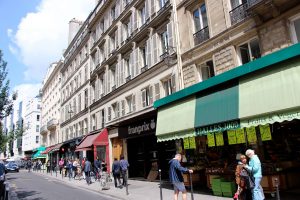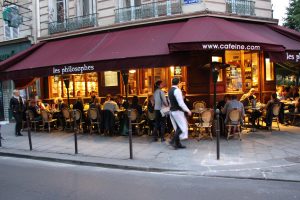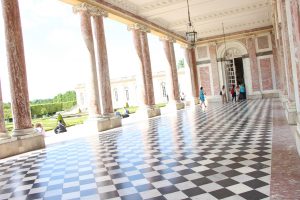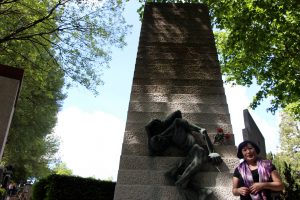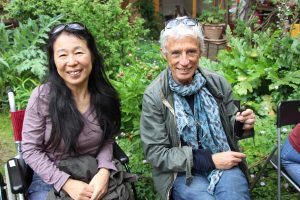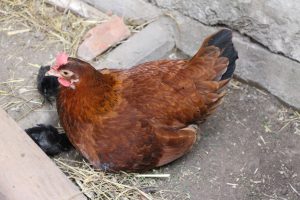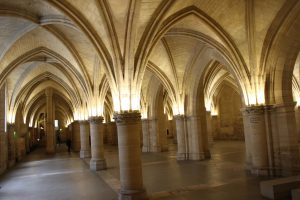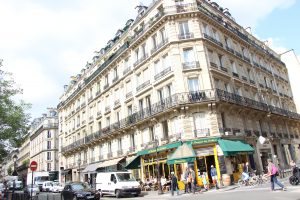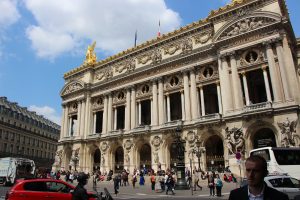France 2015: Paris & Versailles
I lived in Paris from January through June 1992 but did not have the opportunity to return to the City of Light until May 2015; my week in Paris was a trip down memory lane, bringing back a flood of memories from the six months I spent there 23 years before. During the course of the week, I took one big day trip, To Versailles, which I did not visit while I was living in Paris in 1992 but rather in December 1981, while I was living in London. These are some photos I took in May 2015 and some thoughts about the city I lived in and fell in love with like so many American expatriates before me…
Thursday, May 21
I flew out of JFK on Wednesday, May 20 and arrived somewhat bleary-eyed at Charles de Gaulle on Thursday, May 21. CDG may have once been state-of-the-art, but the aéroport has not aged well. Before landing, I tried to take a picture out of my window, but my camera wouldn’t work, so when I met up with my friend Joyce, the first thing we did was go to a camera repair shop. Unfortunately, the camera could not be repaired on-site; since it would take 10 days to repair, I decided to buy a new one and found a good digital camera at L’Instantané; it wasn’t cheap, but I took 2,000 photos with it in one week in Paris and then over 6,600 photos in a month in Korea the following month, which made it worth it to buy.
Joyce and her partner Ellen were spending six months in Paris and invited me to stay with them for a week; it was an opportunity I didn’t feel I could pass up, especially as it had been a full 23 years since I’d been in the City of Light. Joyce very helpfully took me to a little shop where I bought a SIM card I could use in my cell phone during my week in Paris so I could stay in touch with her by phone and text message. Then we went back to their apartment in the rue Sedaine. The three of us then met up with friends of theirs at Les Philosophes — ironic because it was one of the few restaurants I dined in while living in Paris in 1992; and perhaps doubly ironic, given my background and interest in philosophy.
With my new digital camera from L’Instantané, I took a shot of the Place des Vosges one of the most architecturally and historically important squares in Paris, as the first mixed-use urban development (as we would call it nowadays) in France, with rows of shops at street level and elegant apartments above ground level.
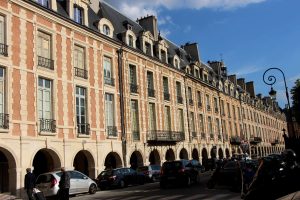 Place des Vosges in the Marais (4ème)
Place des Vosges in the Marais (4ème)
Les Philosophes had been renovated since I last saw it and the interior was less quaint but considerably more accommodating than in the old days; but we sat outside, dining al fresco, enjoying the relatively warm May evening air.
The food was good and it was interesting meeting Ellen and Joyce’s friends; but I was struck by the coincidence that they had chosen one of the few restaurants in Paris that I had actually dined at while I was living there in 1992. ‘Philosophes’ in French can simply mean ‘philosophers,’ but it has a particular meaning in French cultural and political history, referring to Voltaire, Diderot and the other writers of the French Enlightenment who were not for the most part systematizing philosophers like the Germans Leibniz or Kant or the English philosophers Hobbes or Locke; the French Philosophes had a particular agenda, which was to move France beyond the religiously based disputes of the Wars of Religion which tore France apart in the 16th century and into an era of rational discussion not based on religious authority or scriptural references.
 The restrooms had been completely renovated since I was last at Les Philosophes back in 1992, with gleaming steel installed and clever little quotes on the mirrors (4ème).
The restrooms had been completely renovated since I was last at Les Philosophes back in 1992, with gleaming steel installed and clever little quotes on the mirrors (4ème).
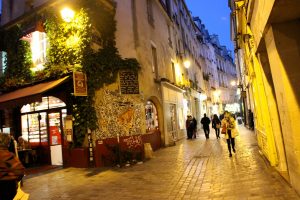 On the way home, we walked down the rue des Rosiers, the main street of the old Jewish quarter of Paris…
On the way home, we walked down the rue des Rosiers, the main street of the old Jewish quarter of Paris…
 We passed through the Place des Vosges around midnight, beautifully mysterious with only street lights to light our way through the great square…
We passed through the Place des Vosges around midnight, beautifully mysterious with only street lights to light our way through the great square…
Friday, May 22
On Friday, I took my only day trip out of Paris, taking the SNCF train to Versailles to see the most famous royal palace in Europe. I hadn’t actually visited Versailles during my six months living in Paris in 1992 and my only previous visit to the château and its gardens was in December 1981, when I was living in London; my memories of Versailles were not happy ones, as we had gotten thoroughly soaked walking through the vast gardens in the rain because we’d left the umbrella in our hotel room.
 rue Sedaine in the 11ème (5.22.15)
rue Sedaine in the 11ème (5.22.15)
That morning, I set out from the apartment in the rue Sedaine, eager to get to Versailles and all the more excited, having recently read a 600-page biography of Louis XIV. That’s not to say I’m a fan of Louis; le Roi Soleil was a distinctly mixed bag. The first 10 years of Louis’ reign was a stunning success, but his decision to make war on the Dutch Republic was the beginning of endless wars that eventually bankrupted France and ultimately contributed to the trajectory that led to the French Revolution.
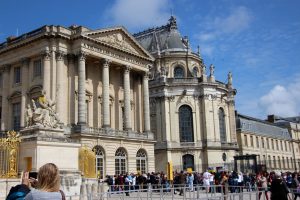 Versailles: château de Versailles on the left, the royal chapel on the right
Versailles: château de Versailles on the left, the royal chapel on the right
I didn’t buy a ticket in advance and my heart sank when I saw the enormous line to get into the château when I arrived around 11 a.m.; fortunately, it only took 45 minutes to get to the ticket counter, which was surprising given the length of the queue.
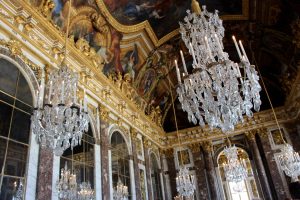 la Galerie des Glaces au château de Versailles
la Galerie des Glaces au château de Versailles
When I first visited the château way back in December 1981, the Galerie des Glace was not at all crowded, in part because it was raining and dreary, and the interior of the château was correspondingly dreary. When I returned in May 2015, the Hall of Mirrors was swamped at regular intervals by waves of tourists, like waves on the Normandy beaches. And 24 years later, everyone was taking ‘selfies’ with camera phones, something one would not have seen in 1981; in fact, there was an African immigrant in the courtyard of the château selling selfie sticks; I can’t imagine what Louis XIV would have thought of that~!
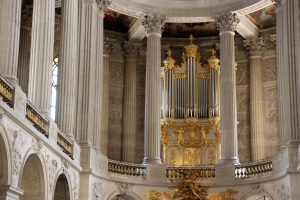 la Chapelle Royale au château de Versailles
la Chapelle Royale au château de Versailles
When I was an undergraduate, I studied the music of François Couperin (1668-1733), who was along with Jean-Philippe Rameau, the greatest composer of the French Baroque. Couperin’s two books of organ works were published in 1690 and I studied a number of pieces from both the Messes pour les Couvents and the Messes pour les Paroisses. Couperin was appointed organist of the Chapelle Royale at Versailles in 1693, so it was thrilling to be able to see the great organ in the Chapelle Royale that Couperin himself played on for Louis XIV.
 dans la Galerie des Glaces au château de Versailles
dans la Galerie des Glaces au château de Versailles
The Galerie des Glaces is the most celebrated hall in all of Versailles, the glittering core of Louis XIV’s enormous château; it was the scene of some of the most glittering and politically significant events the château saw in the century when it was the nexus of political power in France and in the centuries to follow, including the proclamation of King Wilhelm of Prussia as emperor of the new German Reich in 1871 and the signing of the Treaty of Versailles in 1918. But to me, the most romantic event ever to have taken place in the Hall of Mirrors was the celebrated Bal des Ifs held in 1745 to celebrate the engagement of the dauphin to Maria Teresa, the Spanish infanta; it was at that Yew Tree Ball where Louis XV met and fell in love with the young Jeanne-Antoinette Poisson, creating her the Marquise de Pompadour; Madame de Pompadour was the first bourgeoise in Bourbon French history to occupy the position of maitresse-en-titre and as the king’s official mistress would reign over the court at Versailles until her death.
Jules Hardouin-Mansart designed and built the Grand Trianon in 1687; it’s the second largest palace on the grounds after the château but even so, much smaller; the elegant pink marble is beautiful but could leave some cold.
Reading numerous books about Bourbon France and Versailles, including John B. Wolf’s 600-page biography of Louis XIV, gave me more background than most tourist bring with them to Versailles and helped bring all of those characters from the ancien régime alive. I’m guessing that most tourist who wander through the palaces and gardens at Versailles would only have vague familiarity with Louis XVI and Marie-Antoinette; for me, they are very nearly as real to me and as complex as anyone I know; they are also profoundly flawed, including Louis XIV, Louis XV and Louis XVI, as well as Marie-Antoinette. I was astonished to read in Wolf’s biography that it was Louis XIV who set up the first concentration camp for political prisoners, for French Huguenots who tried to escape France after his revocation of the Edict of Nantes, his biggest mistake by common consent of informed historians.
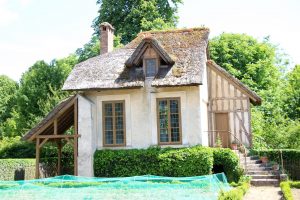 the gardener’s house in the ‘domaine de la reine’ created by Marie-Antoinette around her hameau (hamlet) at Versailles
the gardener’s house in the ‘domaine de la reine’ created by Marie-Antoinette around her hameau (hamlet) at Versailles
When I visited Versailles in May 2015, the biggest change was the reconfiguration and ‘branding’ of the ‘Domaine de la Reine,’ the area of the vast estate that was the special preserve of Marie-Antoinette. The hameau (hamlet) where the queen of France played milkmaid with her ladies-in-waiting seems like a pretentious folly to us, but reading in the biography of Marie-Antoinette by Evelyne Lever about the oppressive court ceremonial the queen had to deal with gives one a better understand of how this playing at milkmaid must have been a relief from the constraints of court life.
Louis XV built the Petit Trianon for his last maitresse-en-titre, Madame du Barry; it’s an elegant neoclassical building designed by Ange-Jacques Gabriel in 1768; but after the old king’s death, his grandson unceremoniously kicked out the late king’s mistress and gave the little palace to his wife as a birthday present; from that moment ever after, Marie-Antoinette regarded the Petit Trianon as her home as well as a refuge from the château and its oppressive court ceremony.
Marie-Antoinette continues to fascinate us to the present day; in truth, she was neither a heroine nor a saint nor was the doomed queen the nymphomaniac she-devil she was caricatured in in countless frankly deeply misogynist pamphlets printed during her reign; the woman known to her Habsburg family as ‘Antonia’ was a profoundly flawed character who brought her doom on herself with countless mistakes but who nonetheless rose to a level of true nobility in her last year of life, purified in some sense by her deep suffering, and one has to see the arc of her life in the historical, cultural and political context in which she lived it.
Saturday, May 23
I did not visit the Cimitière Père Lachaise when I was living in Paris in 1992, so I was delighted to have the opportunity to visit the most famous cemetery in the city when I was there in May 2015.
 la famille Sauron dans la Cimitière Père Lachaise (20ème)
la famille Sauron dans la Cimitière Père Lachaise (20ème)
As a Tolkien fan, I was amused to see the grave of the Sauron family in the cemetery.
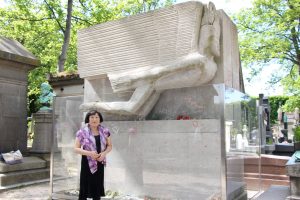 the sarcophagus of Oscar Wilde
the sarcophagus of Oscar Wilde
There were many famous people whose graves I wanted to see in the Cimitière Père Lachaise, but at the top of the list were those of Oscar Wilde, Frederic Chopin and Edith Piaf, all of whom hold a special place in my heart. Wilde, the outrageous trailblazer for LGBT rights and the author of “The Importance of Being Earnest,” one of the wittiest plays in the English language, has an enormous sarcophagus, which is so popular and has been kissed so often, now has a plastic wall around it to protect it from overly enthusiastic admirers.
When I visited the Cimitière Père Lachaise in the 20ème for the first time in May 2015, I found this memorial to the victims of the Nazi concentration camp at Mauthausen; it wasn’t long ago that I discovered that Mauthausen was one of three Nazi concentration camps that my father helped liberate at the end of World War II, so it was especially meaningful to me.
 at the grave of Edith Piaf in the Cimitière Père Lachaise (20ème)
at the grave of Edith Piaf in the Cimitière Père Lachaise (20ème)
Edith Piaf is far and away my favorite singer of French chansons populaires and I was happy to see a group of Piaf fans come to her grave when I was there and delighted to hear them break into popular Piaf songs.
After strolling through the cemetery, the young Austrian I wandered through Père Lachaise with and I came out to find a marché aux puces/vide grenier outside the cemetery grounds, where I found some trinkets to take home with me as gifts for friends. I then rushed back to the apartment for dinner with Ellen and Joyce, bringing dessert with me.
Sunday, May 24
In the morning, I went with Joyce to the green market known as the ‘Marché Bastille’ in the Boulevard Richard Lenoir to shop for fruit and vegetables. Joyce and Ellen then went up to the community garden maintained by the Association L’îlot Lilas (295 rue de Belleville 75019 Paris) at rue Haxo, where Isabelle greeted us and introduced us to some of the ‘regulars.’
The Lilolila community garden is a wonderful example of a community-based cooperative organization maintaining a productive bit of greenery in the concrete and relatively un-green 19th arondissement.
I had a number of delightful conversations in the Lilolila community garden, including with a Frenchman named Philippe and his Japanese wife Maki. I was gratified when Philippe told me he thought I was a native francophone and that he had never met someone who wasn’t a native French speaker who spoke French so well.
I was charmed to see a little henhouse in the garden.
Monday, May 25
Monday was Marais day for me, a trip down memory lane in the neighborhood composed of by the 3rd and 4th arondissements that I lived in and called home for six months in 1992.
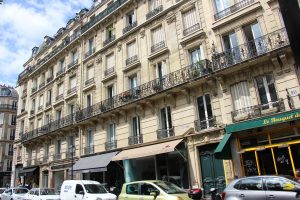 29, rue des Archives: where I lived for six months in 1992
29, rue des Archives: where I lived for six months in 1992
I just had to pass by my old building in the rue des Archives during my week in Paris in May 2015. The building was largely unaltered, except for a few of the shops and cafés on the street level.
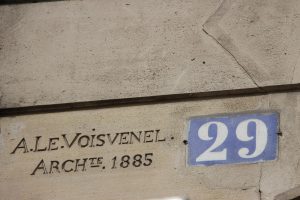 29, rue des Archives, designed by architect Albert Le Voisvenel (1885)
29, rue des Archives, designed by architect Albert Le Voisvenel (1885)
I don’t know if I ever noticed it when I was living in the building, but passing by in May 2015, I saw the name of the architect and the date of the building’s construction carved into the side of the building, and reflected on the fact that it was built just three years before my grandmother’s birth.
 Rue Vielle du Temple (a street in the Marais) (4ème)
Rue Vielle du Temple (a street in the Marais) (4ème)
Rue Vielle du Temple holds a special place in my memory; it was the street I walked up to go to my boyfriend’s apartment back in 1992; I couldn’t remember the address of his building or find it when I was in Paris in May 2015, so I had to content myself with a stroll down the Rue Vielle du Temple.
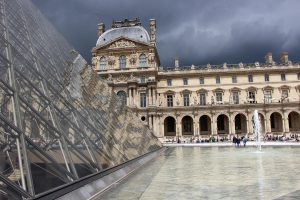 la pyramide du Musée du Louvre (1ère)
la pyramide du Musée du Louvre (1ère)
I can’t actually remember if I visited the Louvre during the six months I was living in Paris more than once, but it was before the pyramid designed by I.M. Pei was constructed, so it was interesting to enter through the pyramide for the first time. While the line looked enormous, it ended up being about 45 minutes, just like the line to get into the château and into Sainte-Chapelle.
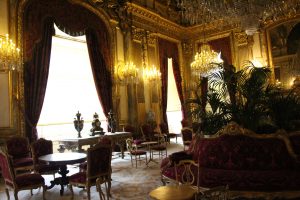 les appartements Napoléon III au Musée du Louvre (1ère)
les appartements Napoléon III au Musée du Louvre (1ère)
I had my heart set on seeing “Pélérinage à l’Île de Cythère,” my favorite painting in the Louvre and one of my favorite works of art in any museum, but Antoine Watteau’s vast canvas was in a wing of the museum that was closed for renovations when I arrived; I was disappointed, but the compensation was seeing the Appartements Napoléon III for the first time and soaking in their splendid opulence.
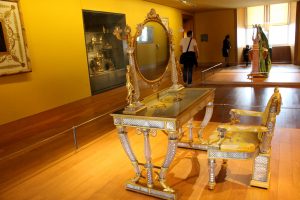 Musée du Louvre (1ère): table et fauteuil de toilette (Paris, c. 1819) designed by Marie-Jeanne-Rosalie Desarnaud-Charpentier (“acquis par la duchesse de Berry” pour “son chateau de Rosny-sur-Seine”) in the Louvre on my last trip to Paris (5.25.15)
Musée du Louvre (1ère): table et fauteuil de toilette (Paris, c. 1819) designed by Marie-Jeanne-Rosalie Desarnaud-Charpentier (“acquis par la duchesse de Berry” pour “son chateau de Rosny-sur-Seine”) in the Louvre on my last trip to Paris (5.25.15)
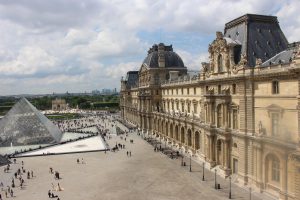 la Cour du Musée du Louvre (1ère)
la Cour du Musée du Louvre (1ère)
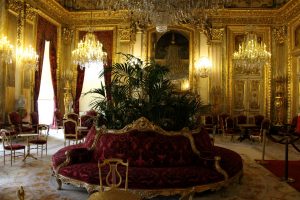 les appartements Napoléon III au Musée du Louvre (1ère)
les appartements Napoléon III au Musée du Louvre (1ère)
les appartements Napoléon III: salle à manger, Musée du Louvre
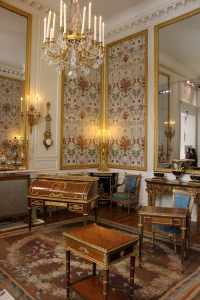 Louis XVI period room in the Musée du Louvre (1ère)
Louis XVI period room in the Musée du Louvre (1ère)
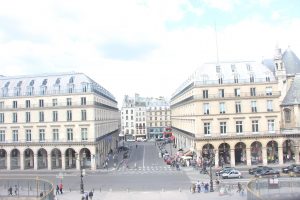 Rue de Rivoli from the Musée du Louvre (1ère)
Rue de Rivoli from the Musée du Louvre (1ère)
I spent some time in the Place des Vosges on Monday evening looking for a suitable restaurant for diner, settling on the Place Royal, then calling Joyce to bring Ellen down there to meet me at the restaurant.
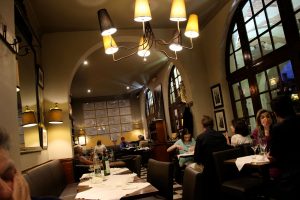 Place Royal in the Place des Vosges
Place Royal in the Place des Vosges
Ellen, Joyce and I enjoyed Place Royal, an elegant and rather expensive restaurant in the Place des Vosges with superb food; it was the most lavish dinner of the entire week in Paris; it was my gift to them for the week of hébergement and it wasn’t cheap.
Tuesday, May 26
 Art Nouveau Style Nouille cast iron entrance at the Place de la Bastille Métro station
Art Nouveau Style Nouille cast iron entrance at the Place de la Bastille Métro station
I love Art Nouveau and especially the Style Nouille (‘noodle style’) and was delighted to come across the cast iron entrance at the Place de la Bastille Métro station.
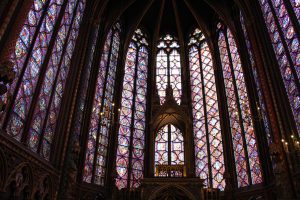 Sainte Chapelle on the Île de la Cité
Sainte Chapelle on the Île de la Cité
Sainte Chapelle is in my view the most beautiful church in the world. I was fortunate enough to be visiting Paris in May 2015, just after the original stained glass windows were remounted after seven years of cleaning them; when the sun finally came out, the windows were dazzling with the light streaming through them.
 Sainte Chapelle is a miracle of Gothic design and one of the supreme masterpieces of French architecture
Sainte Chapelle is a miracle of Gothic design and one of the supreme masterpieces of French architecture
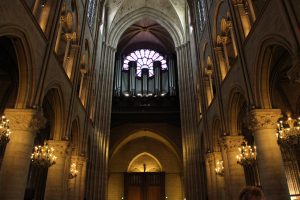 la cathédrale Notre-Dame de Paris: rose window & organ
la cathédrale Notre-Dame de Paris: rose window & organ
Sainte Chapelle shares the Île de la Cité with Nôtre Dame de Paris. While the cathedral and seat of the bishop of Paris is darker and lacks the stunning stained glass windows of Sainte Chapelle, Nôtre Dame is far more historically important and politically significant; fortunately, it is also much easier to get into; there was no line when I arrived there after leaving Sainte Chapelle around the corner.
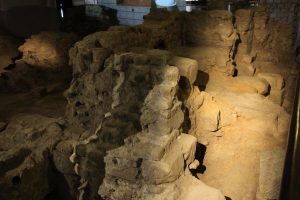 La crypte archéologique de l’île de la Cité est un musée de la Ville de Paris, situé juste sous le parvis de la cathédrale de Nôtre-Dame
La crypte archéologique de l’île de la Cité est un musée de la Ville de Paris, situé juste sous le parvis de la cathédrale de Nôtre-Dame
Underneath Nôtre Dame is a large archeological crypt that contains some of the foundations of ancient Paris; I’d never seen it before and took the opportunity to explore it after visiting the cathedral.
I crossed the Île de la Cité many times while living in Paris and had seen the Conciergerie from afar but had never gone inside; since the ticket to Sainte Chapelle included admission to the Conciergerie as well, I thought I would check out this imposing prison where Marie-Antoinette and thousands of others were imprisoned during the French Revolution and it turned out to be quite fascinating.
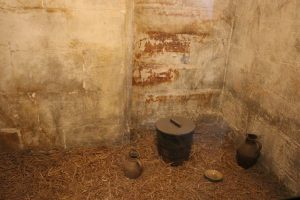 Conciergerie: a cell for poor prisoners
Conciergerie: a cell for poor prisoners
 Conciergerie: a cell for wealthy prisoners
Conciergerie: a cell for wealthy prisoners
Even in prison, class distinctions were paramount: the cells for poor prisoners in the Conciergerie were filthy hovels, but those for prisoners who could pay an extra fee were relatively clean by comparison and those prisoners (aristocrats, undoubtedly) had cots to sleep on instead of straw. Seeing the cell where Marie-Antoinette lived out the last months of her life was really meaningful after having read two biographies of her; while I’m no fan of hers, the doomed queen rose to a level of true nobility in her last few months; had she displayed the same wisdom in her many years of foolish, frivolous, extravagant and even treasonous behavior as queen, she might well have kept her head.
 courtyard of the Hôtel Carnavalet
courtyard of the Hôtel Carnavalet
After leaving the Conciergerie, I visited the Hôtel Carnavalet, which I had first seen when I was living in Paris in 1992; it was a wonderful reminder of the sweep of history of this great city.
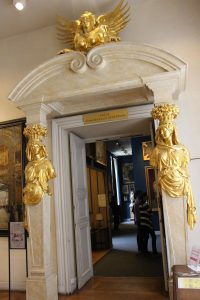 golden statues at the entrance to one of the rooms in the Hôtel Carnavalet
golden statues at the entrance to one of the rooms in the Hôtel Carnavalet

I then proceeded to the Hôtel Salé, which houses the Musée Picasso, my first visit to this wonderful museum. The breadth and depth of the Picasso collection is unique in all the world, but the exceptionally beautiful elegance of the Hotel Salé itself makes a visit to this grand building worth one’s while.
I came across the Musée Cognacq-Jay on my walk through the Marais after visiting the Musée Picasso. Called the ‘Musée du XVIIIe siècle de la Ville de Paris,’ the Musée Cognacq-Jay is a tiny little jewel of a museum that can be seen in less than half an hour; while it can’t compare to the Musée Picasso in the importance of its collection and while the building that houses it lacks the grandeur of the Hôtel Salé, the Musée Cognacq-Jay will be a delight to anyone interested in the 18th century as I am.
 an 18th c. clock in the Musée Cognacq-Jay
an 18th c. clock in the Musée Cognacq-Jay
Wednesday, May 27
On my last day in Paris, I paid a final visit to the Place des Vosges and then went for the first time to the Hôtel de Soubise, which houses the Archives Nationales.
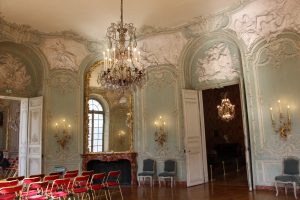 Hôtel de Soubise: le Salon du Prince (4ème)
Hôtel de Soubise: le Salon du Prince (4ème)
 Hôtel de Soubise: le Salon du Prince (4ème)
Hôtel de Soubise: le Salon du Prince (4ème)
 l’Hôtel de Soubise, a masterpiece of the Rococo style (4ème)
l’Hôtel de Soubise, a masterpiece of the Rococo style (4ème)
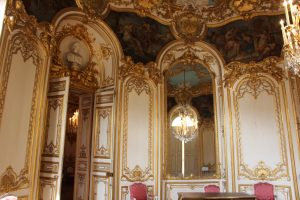 Hôtel de Soubise: le Salon de la Princesse (4ème)
Hôtel de Soubise: le Salon de la Princesse (4ème)
The Hôtel de Soubise has only two rooms really worth seeing, but they are exceptionally beautiful and important: the Salon du Prince and the even more beautiful Salon de la Princesse, masterpieces of the Rococo.
One last farewell to the building in the rue des Archives where I lived in 1992.
 …at the Arc de Triomphe on my last day in Paris
…at the Arc de Triomphe on my last day in Paris
And then the Arc de Triomphe, followed by the Palais Garnier, the masterpiece of Second Empire architecture.
 dome of the Galleries Lafayette
dome of the Galleries Lafayette
And finally, a glimpse of the sumptuous dome of the Galleries Lafayette before bidding Paris adieu.
